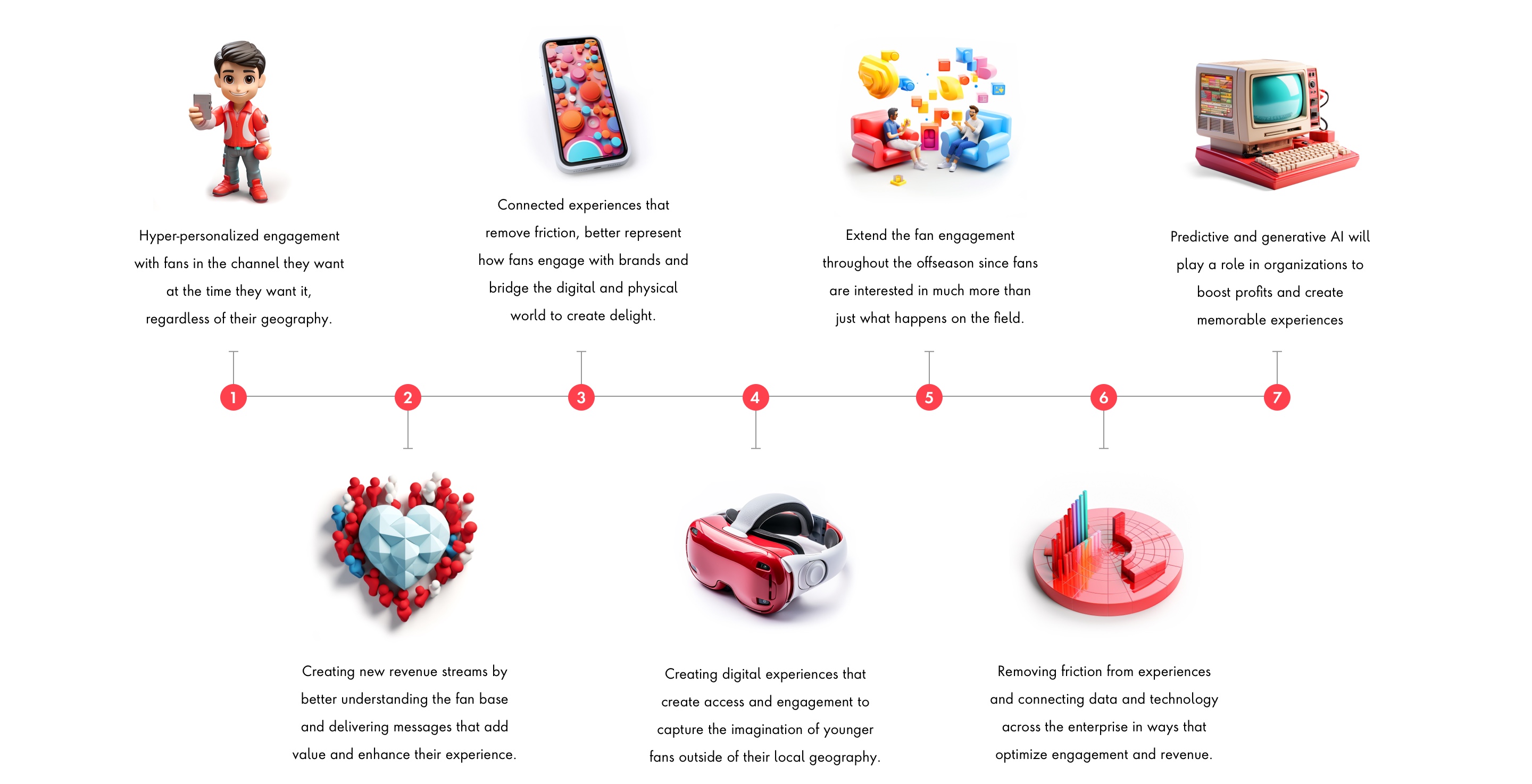What issue can we solve for you?
Type in your prompt above or try one of these suggestions
Suggested Prompt



Telecommunications, Media & Technology
The business model for professional sports teams is changing from media-centric to engagement-centric—all driven by the fans. If sports teams do not pivot, they could be at risk financially. They must better understand today’s fans and apply digital tools to meet their needs.
Focus on the Fans: What Professional Sports Teams Should Consider to Drive Revenue and Protect Financial Investments
The landscape of sports is shifting rapidly, with significant cracks appearing in the traditional value chain for modern sports organizations looking to leverage the enthusiasm of sports fans and translate that into profitability. Creating value in the sports industry requires a different and evolved approach, delivering a great product, engaging fans through multiple channels, maximizing revenue streams and creating a positive impact at a community level.
In order to achieve this, organizations must better understand today’s fans and their changing expectations and apply digital tools to better attract and meet their needs. One key area of change will be at the core of their business models, transforming from a media-centric business model to an engagement-focused model in order to drive growth and maximize financial investments.
Sports entertainment is lucrative, but the industry needs to keep pace with evolving consumer needs
Sports teams and leagues have been on a strong run over the last 20 years. The largest leagues in North America (NFL, NBA, MLB, NHL) have maintained a wide and exclusive economic moat that has provided returns surpassing the S&P 500 index by over 303 percent. It’s no wonder that the major leagues are being swarmed by private equity investors looking for high returns on investment.
In some aspects, the future is looking bright. Media rights are presently pegged at $55 billion and are projected to surpass $60 billion in the next two years. The NBA is looking to increase its current media deal by three times and the NFL dominates broadcast airwaves, with 19 of the top 20 most-watched broadcasts in 2022. Overall, the sports industry in North America will grow to $83 billion in value by 2024.
What’s the challenge, then? The industry is ripe for disruption as current generations brush up against outdated fan engagement norms and the proliferation of digital channels—whether it be for viewing, betting or fantasy—the sports world will look very different in the coming years. Developments in arenas like social media, the metaverse and the increasing integration of artificial intelligence and generative AI hold the potential for transformative solutions that create new avenues of opportunity for sports organizations looking to drive growth and accelerate fan engagement from a consumer perspective.
It’s time for teams to get personal—how well do they really know their fans?
Sports fans lead massive change
By 2026, 41.6 percent of the U.S. population will have become ‘cord-cutters,’ meaning that almost half will cancel their subscriptions to multichannel television services available over cable or satellite, stop paying for television channels or reduce the number of hours of subscription TV they view in favor of rival media available over the internet.
The generational divide is real in the sports industry. Younger audiences are increasingly viewing short-form content of sporting events. Instead of following teams and leagues, they are following players and their social platforms. In fact, 33 percent of Gen Z do not watch live sporting events, one in five have not attended a live event this year and 28 percent are apathetic toward sports. It’s clear that for sports fans, the game is looking a lot less recognizable. And that should make major leagues take action.
A fragmented landscape
Social platforms that extend engagement beyond the ‘game’ offer alternative storylines and channels to connect with players, communities and sports. The race for meeting Gen Z and other fans where they are and finding inventive ways to engage with them authentically from a sports brand perspective is in high gear. But in doing so, media properties, leagues, teams and ancillary experiences like fantasy, sports betting, stats, memorabilia and long-form editorial are often creating a fragmented environment, one where fans don’t recognize their team in a way that makes sense to them.
In the most disconnected of experiences, sports fans are forced to traverse multiple platforms to find what they are looking for. The challenge remains to create unified and impactful experiences across multiple channels that engage and retain sports fans’ attention beyond one game at a time.
In addition, new kinds of fan bases are also making an impact in the industry and, subsequently, sports organizations should take note—sports have often been used to shape societal values or unify national identity. Women’s sports teams and leagues have grown out of the shadow of men’s sports leagues by offering their players’ Name and Image Likeness (NIL) to a plethora of important causes. Organizations should consider how to best engage and include different types of audiences and communities in operational models of engagement.
The opportunity ahead
Organizations in the sports industry must transform from a media-centric business model to an engagement model, which enables a future version of the sports world that enhances experience, creates more personalized engagement and drives towards a greater ROI from a revenue perspective. Only then will sports organizations be able to predict trends and adapt to the changing digital landscape, finding new ways to reinvigorate the value chain.
The New Business Model
The media-centric business model is changing to an engagement-centric business model. Here are seven main takeaways as the industry shifts to a focus on engagement.

It’s time to focus on the fans and drive future growth
The biggest question is who will lead the way? Which team will take hold of a new fan base that thrives on experience, multichannel personalized engagement and a brand that leans into the new technology that’s bringing everyone together? The teams that get it right will create a whole new face of fan loyalty and continue to profit.
Related Reading
-
![]()
Insight
Always-On Engagement: Customer Relationships Built on Value
Always-on engagement moves away from traditional campaign-based marketing to relevant, real-time communication.
-
![]()
Case Study
Publicis Sapient Case Study: How a Sports Retailer Transforms for the Digital Era
A top U.S. sports retailer needed to modernize its commerce platform and streamline its processes and strategy for digital retail. It turned to Publicis Sapient to implement a cloud-based digital commerce platform.
-
![]()
Insight
Subscription Gaming & the Tech-as-a-Service Model
Learn about the four value streams and four building blocks for creating life-long customer value within new technology-as-a-service frameworks.







